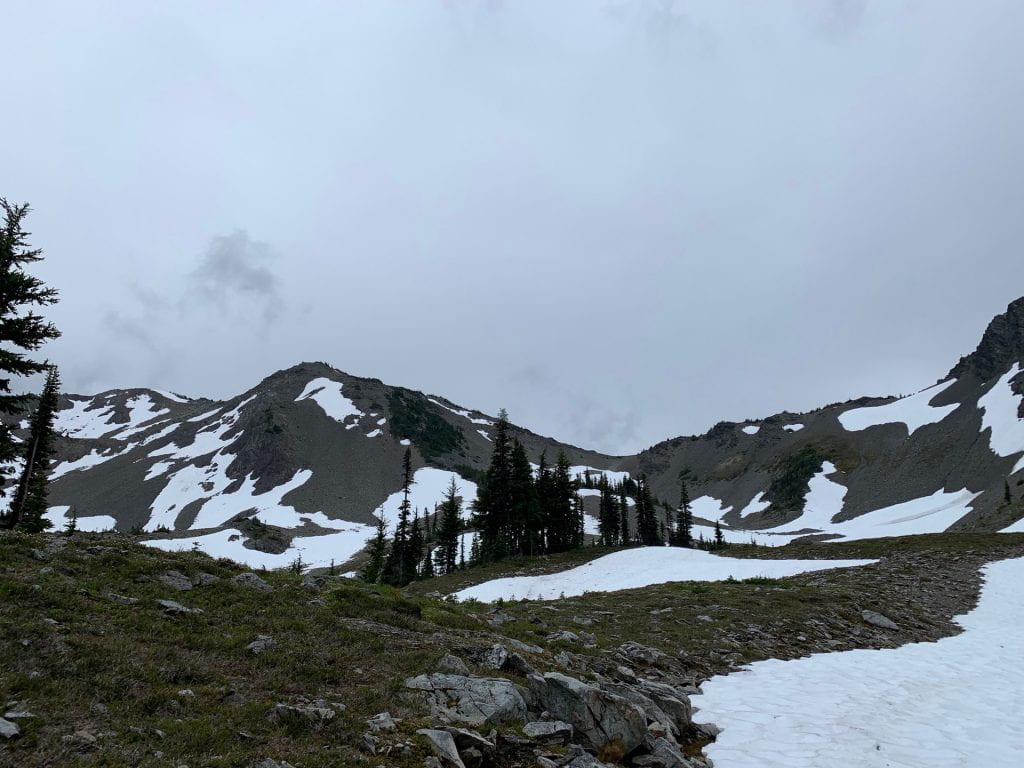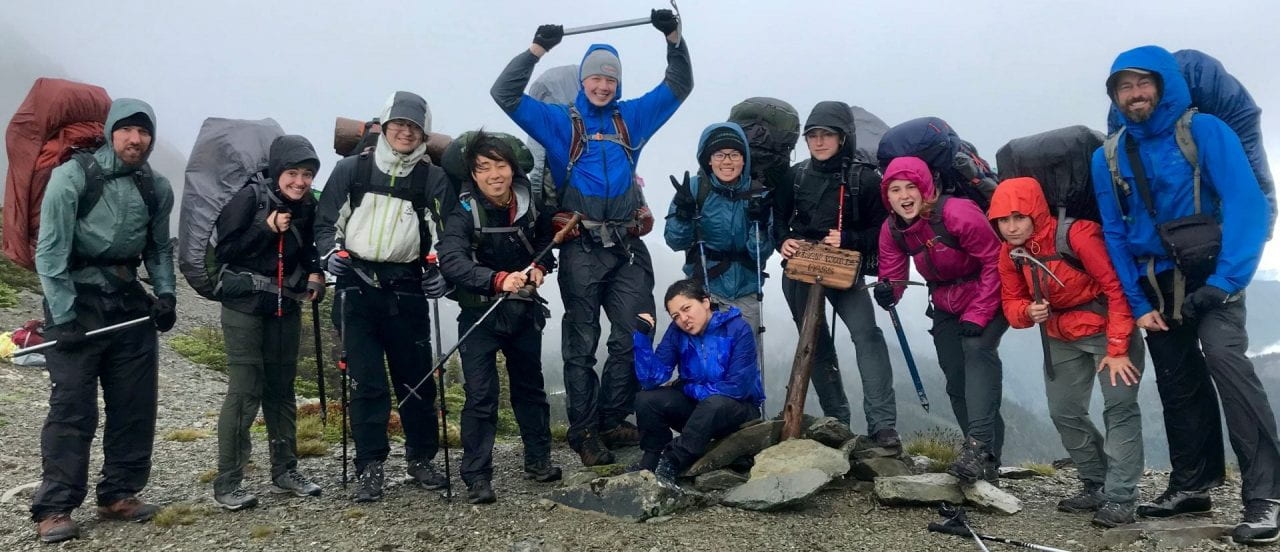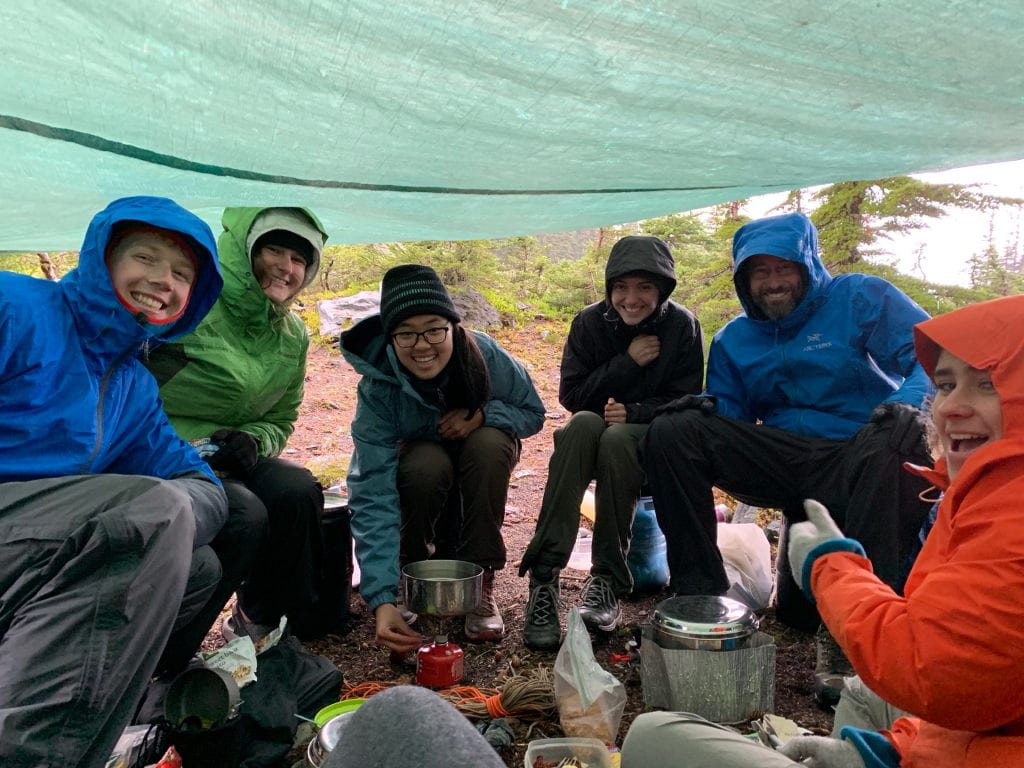Today we embarked on our first alpine hike up to the lake at Gray Wolf Pass. Following a breakfast of oatmeal and our group’s signature late morning start, we set off from Falls Camp. Our hike was unique compared to the previous few days. This time we started in the forest but slowly made our way up above the tree line – little did we know this was the first of many challenging climbs to come. Throughout the day we observed how the species composition changed at various elevations, and (thankfully) mosquitoes were no longer bothering us once we got up to the high elevation camp. Sometimes it felt as if we were being eaten alive! We crossed many thin, un-railed, wooden bridges that tested our balance. Katie and Tim taught us that it’s best practice to unbuckle our backpack waist belts when we cross in case we fall off. Luckily, none of us did.
As we climbed higher, subalpine firs replaced hemlocks and Douglas firs. At the camp, even subalpine firs became scarce. The area experiences very short growing seasons, so many of the trees up there were extremely old despite their small size. We learned to be careful not to step on the vegetation in these areas.
Unfortunately, the sun we started the day off with didn’t stay. A large storm came through right around the time we arrived at the camp and it rained all day and night, with wind howling across the pass above us. This was no drizzle – the wind shook around our tents and our stuff got soaked. Although the weather was rough, the site was stunning and I enjoyed a few moments by the lake when I felt strong enough to brave cold.
After the rain started, we managed to put up the tarp and all huddled close together to fight the cold for mine and Amy’s discussions. As can be seen in the photo, we somehow remained in high spirits and big smiles. My cook group warmed up with pesto tortellini (yum) and hot drinks and I started my discussion. I talked about financial barriers to accessing the wilderness, such as the entrance costs to parks and how this affects low income families. We talked about rising costs, how much parks costs in maintenance, and the pros and cons of free access to national parks. As this moved to a broader subject of wilderness accessibility, Amy jumped in and talked about POC in the wilderness. It was powerful to hear that when she saw someone who looked like her similarly backpack, she felt that meant she could do it too. National parks are dominated by white people, so we discussed how to encourage more POC to use the parks and what barriers POC face when they choose to use them. She shared an interesting magazine article about an African-American woman that hiked the Appalachian Trail who had received comments such as “black people don’t hike.”
Finally, we were too cold to bear it any longer so we took an early night in. I slept with 4 layers on and listened to the storm continue overnight. Luckily, mine and Amy’s tent managed to stay dry and mostly warm!

Looking up to Gray Wolf Pass. JAWS1 is beginning to literally roar over the pass. Later in the week, the strongest summer jet stream ever was recorded moving right over the Olympic Peninsula.
Overall, this trip was well summarized in Day 4 as it was throughout – impossible without each other. The storm of the day (and the following days) really showed me what optimistic, friendly, and persistent people I was surrounded by! Not only was everyone great, but they were intelligent and led thought provoking discussions that continued to amaze me in their depth and interest.
Wilderness in the Anthropocene is interesting to reflect on with increasing climate change and debatable definitions of ‘wilderness.’ Prior to this class, I had never thought about what wilderness should be defined as and if it needs to change. Although I haven’t totally formed a solid opinion on the answer yet, it has been interesting to hear some point of views that feel preserving national parks as “untouched” undermines protecting the environment everywhere else. Sometimes it feels as if we try to justify or offset our environmentally damaging choices by setting aside sections of environmental utopias that reflect a picture of the past. I think we have a habit of distancing ourselves from the wilderness (or at least ‘wildness’) in an everyday sense as it’s something you need to go far away to get to. Although I still support maintaining protected areas such as Olympic National Park, I feel strongly that environmental protection and prioritization should be emphasized within cities and human spaces. For example, maybe there should be more focus on creating “wild” areas in cities, doing native plant restoration in neighborhoods, etc. What I am not sure on is whether more effort/funds/protection should be placed in preserving existing wilderness spaces or restoring and helping damaged areas recover.
The impact the discussions we led and readings we did continue to surprise me! I’ve questioned my definition of wilderness, became significantly more aware of the complex dimensions of Native American rights in the wilderness, and “Ecotopia” continually made me wonder how our environment in 100 years will look.
To conclude, what an epic trip.



